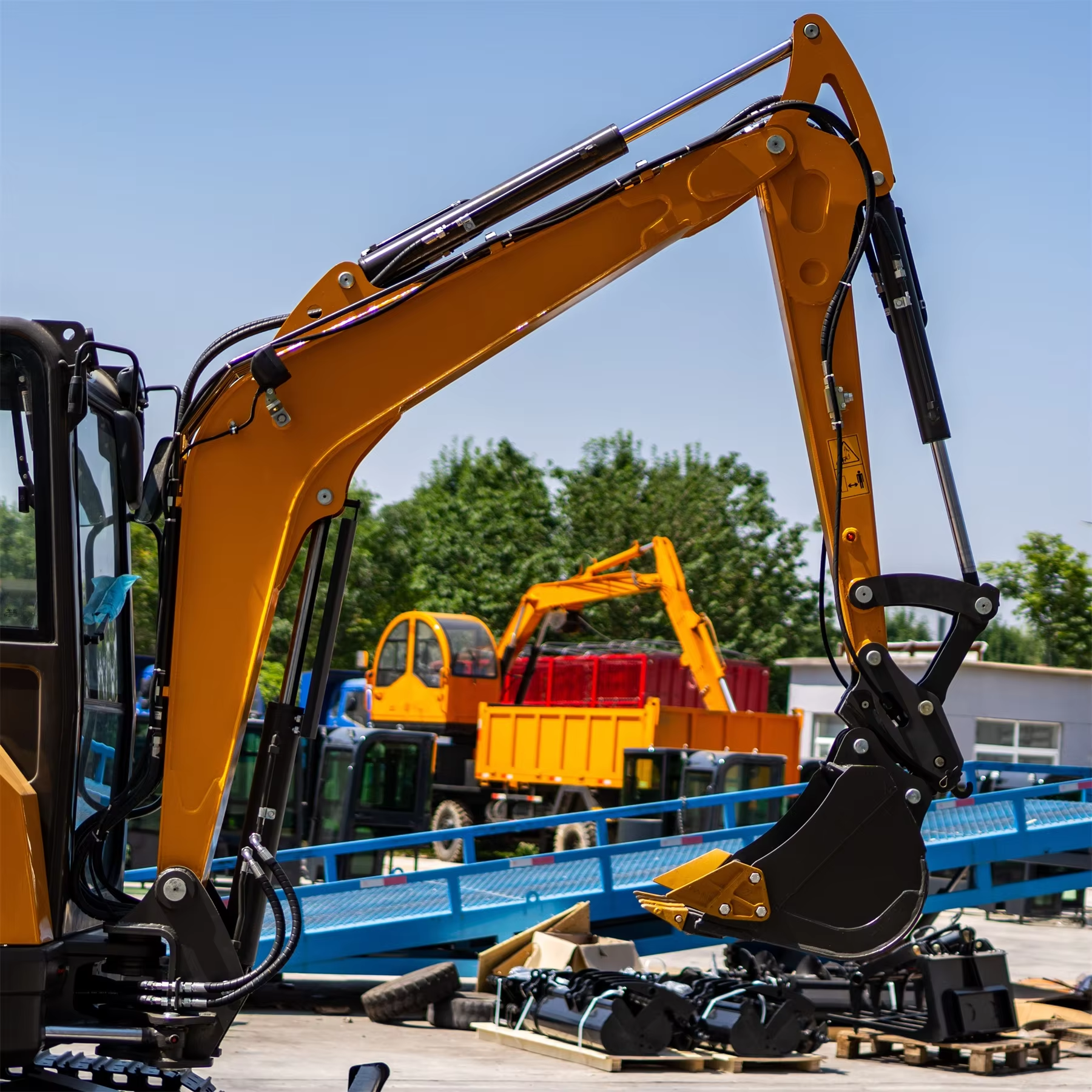The Rise of Mini Excavators in Urban Construction
Urbanization Driving Demand for Compact Construction Equipment
How Rapid Urbanization Is Reshaping Construction Equipment Needs
Urban population density has increased by 18% globally since 2020 (World Bank 2024), creating unprecedented demand for space-efficient construction solutions. Cities like Jakarta and Manila now require 37% more infrastructure projects in confined areas compared to rural zones, driving adoption of mini excavators designed for tight urban layouts.
Growth Trends in the Urban Compact Construction Equipment Market
The Asia-Pacific region dominates with 44% market share, fueled by $1.2 trillion in annual smart city investments. Globally, compact excavator sales are projected to grow at 6.2% CAGR through 2031 (TMR Analysis 2025) as municipalities adopt eco-friendly ordinances requiring low-noise (<72 dB) and low-emission equipment.
Superior Maneuverability of Mini Excavators in Tight Urban Spaces

Navigating confined spaces with compact excavator designs
Small excavators handle city problems really well because they're less than a meter wide, so they can work in places where bigger machines just won't fit. The tight space between buildings and underground pipes doesn't stop them from getting the job done. Workers can turn these machines all around in narrow alleys without creating too many safety issues, which matters a lot when there are people walking by or cars nearby. According to some recent studies from 2024 looking at equipment used in cities, contractors using mini excavators experience about 40 percent fewer problems with space constraints than those relying on regular sized excavators.
Zero-tail swing technology for safe operation near structures
What makes this innovation so valuable is how it keeps the counterweight safely inside those track limits while rotating around, which basically gets rid of that nasty rear overhang problem we all know can be dangerous. Think about working right next to building foundations or close to buried pipes and cables. Mini excavators just don't run into these things like regular machinery tends to do. And let's talk numbers for a second. The smaller space these machines take up actually cuts down on required safety zones by about two thirds, giving workers way more room to operate effectively. That's why city construction supervisors are jumping on board with this tech fast. Nobody wants to deal with repair bills running into tens of thousands after some expensive mistake damages nearby structures.
Retractable undercarriages enhancing mobility on narrow job sites
Adjustable track widths really change what equipment can access. Contractors often pull in their undercarriages to squeeze through tight spots like gates and narrow hallways, then expand them again once they're ready for actual digging work. This back and forth approach keeps the ground pressure around 3.5 psi or lower, so there's less chance of cracking sidewalks or damaging newly planted areas. Industry reports show that jobsites with limited space save about 30-35% in travel time when these adjustable tracks are used. The ability to adjust becomes especially important near buried pipes and cables. Getting positioned just right means workers don't have to dig as much blind, cutting down those costly mistakes by almost half according to field experience.
Key Advantages of Mini Excavators Over Traditional Heavy Machinery
Reduced Site Disruption and Minimal Surface Damage in Urban Zones
Mini excavators bring a level of precision to tight urban spaces that regular sized machines just can't match. According to the ICM Journal from 2023, these smaller machines put about 30 to 50 percent less pressure on the ground compared to their larger counterparts. What does this mean practically? Fewer cracked sidewalks, less damage to pavement surfaces, and saved landscaping around construction sites something that happens all too often with bigger equipment. The special zero tail swing feature lets operators get right up next to buildings safely. No need to worry about damaging walls or foundations while working close quarters. This becomes really important during repairs below sidewalks where utility lines run, or when making changes to old infrastructure in areas with historical significance.
Fuel Efficiency and Lower Operating Costs for Prolonged City Projects
These little machines weigh less than seven tons but still pack a punch when it comes to getting work done. They burn around 40% less fuel every hour compared to regular sized excavators, yet they manage to do about 80 to 90% of what those bigger machines can handle in city environments. Contractors working for municipalities are seeing some serious cash savings too. Some folks we talked to mentioned saving anywhere from $18,000 to $32,000 each year on a single machine thanks to cheaper transportation expenses since they fit on regular trailers without needing special permits, plus they just use less gas overall. And wait until you hear about the electric versions! Cities such as Seattle and Copenhagen that are trying out zero emissions construction sites have seen energy bills drop by somewhere between 60 and 75%. Makes sense really, because who doesn't want to save money while being kinder to the environment at the same time?
Lower Noise Levels Contributing to Community-Friendly Construction
Mini excavators operate around 68 to 72 decibels, way down from the usual 85 to 90 dB range of traditional machines. According to the Environmental Protection Agency report from 2023, this difference cuts noise complaints in half during residential construction work. Take Boston as an example city where local authorities have actually put rules in place requiring these smaller machines for any late night repair jobs happening close to apartment buildings or hospital areas. Some newer hybrid versions come equipped with special hydraulic systems designed to muffle sounds even more. These advanced models bring noise levels down to about 64 dB, which makes them surprisingly quiet compared to those big delivery trucks just sitting idle outside stores all day long.
Technological Innovations Shaping the Future of Mini Excavators

Electric Mini Excavators: Advancing Low-Noise, Zero-Emission Construction
The electric mini excavator is changing how we approach construction in cities because they don't produce exhaust fumes and cut down on noise pollution around 80% less than their diesel counterparts. These machines run quietly below 70 decibels so they can operate day and night near sensitive locations such as hospital grounds or apartment complexes without violating local regulations like those enforced in Londons Low Emission Zones. Contractors report saving roughly 40% on running expenses thanks to lower power requirements and fewer parts needing replacement over time. That makes sense for jobs inside buildings or tight city spaces where fresh air isn't just nice to have but actually required by law in many places now.
Hybrid and Electric Hydraulic Systems Improving Efficiency and Sustainability
When manufacturers combine diesel engines with electric motors in hybrid systems, they get better power management and typically save around 20 to 30 percent on fuel each year. The system itself knows when to flip between power sources depending on what the machine is doing at any given moment. For fine detail work, it draws from batteries, but switches back to the diesel engine whenever there's serious lifting required. What makes these hybrids really stand out is their regenerative hydraulic tech. During those moments when equipment slows down or stops swinging, the system grabs hold of all that wasted motion energy and turns it into usable electricity. This not only keeps machines running longer between refuels but also cuts down on emissions at construction sites located in cities where meeting green standards has become almost impossible to ignore anymore.
Balancing Battery Life and Performance in All-Electric Models
Today's lithium ion batteries can run for around 6 to 8 hours straight in fully electric machines, which is a big improvement from earlier models thanks to smarter power control systems. These systems know when to focus on getting longer runtime versus delivering more power depending on what the job actually needs. The batteries stay at just the right temperature throughout the year because of special cooling tech, and they charge super fast too - most can get back to 80% charge in less than 45 minutes. Real world testing shows that even in tough weather conditions, these electric machines match the digging power of their diesel counterparts right up to the 2 ton size range. That kind of performance makes them serious contenders in construction and industrial applications where reliability matters most.
Design Trends Toward Smarter, More Compact, and High-Efficiency Urban Machines
Manufacturers prioritize space optimization through retractable undercarriages and slimmer profiles enabling operation in alleys under 1 meter wide. Latest innovations include:
- AI-assisted grading systems automatically adjusting bucket angles
- IoT sensors providing real-time diagnostics through centralized fleet dashboards
- Modular attachment interfaces swapping tools in under 90 seconds
This convergence of compactness and connectivity creates highly specialized platforms for complex city infrastructure projects requiring millimeter precision.
Versatility Through Multifunctional Attachments for Urban Applications
Expanding capabilities with attachments like augers, breakers, and grapples
Mini excavators achieve remarkable versatility through quick-mount attachment systems. Operators can switch between multiple tools within minutes using hydraulic couplers, transforming a single machine into a multi-purpose workhorse. Specific attachments expand functional capabilities:
- Augers efficiently drill holes for fencing and utility poles
- Breakers demolish concrete without requiring standalone equipment
-
Grapples handle debris sorting and material recycling tasks
This adaptability reduces the need for multiple machines in confined urban sites, saving contractors both space and operational expenses.
Eco-friendly and noise-reduced attachments meeting city regulations
Urban development today needs equipment that meets tough environmental rules. Manufacturers making attachments are focusing on really quiet models these days. They're using noise reducing hydraulics systems and going electric instead of traditional engines. Most of these new designs stay below 65 decibels while running, about the same level as talking normally next to someone (according to NOHSC data from last year). Switching to electric attachments means no exhaust fumes coming out right where workers are operating, which fits what cities require for cleaner air quality. Looking at industry reports, we see something interesting happening too. The number of companies adopting these electric attachments shot up around three times what it was back in 2019. Why? Because local governments keep pushing for greener building practices and many construction projects now need LEED certifications to get approved.
Frequently Asked Questions (FAQ)
What is the impact of urbanization on construction equipment needs?
Urbanization increases demand for compact construction equipment due to space constraints and infrastructure needs in city environments.
Why are mini excavators favored over traditional heavy machinery in cities?
Mini excavators are favored for their maneuverability, reduced site disruptions, lower noise levels, and environmentally friendly features in urban settings.
How do electric and hybrid excavators contribute to sustainable construction?
Electric and hybrid excavators reduce noise pollution, exhaust fumes, and operational costs while integrating advanced technologies for eco-friendly construction.
What are the key advantages of zero-tail swing models?
Zero-tail swing models improve safety by eliminating rear overhang issues, allowing safer operation near structures and utilities.
How do multifunctional attachments enhance the versatility of mini excavators?
Multifunctional attachments like augers and breakers enable mini excavators to perform diverse tasks, reducing the need for multiple machines on compact urban sites.

